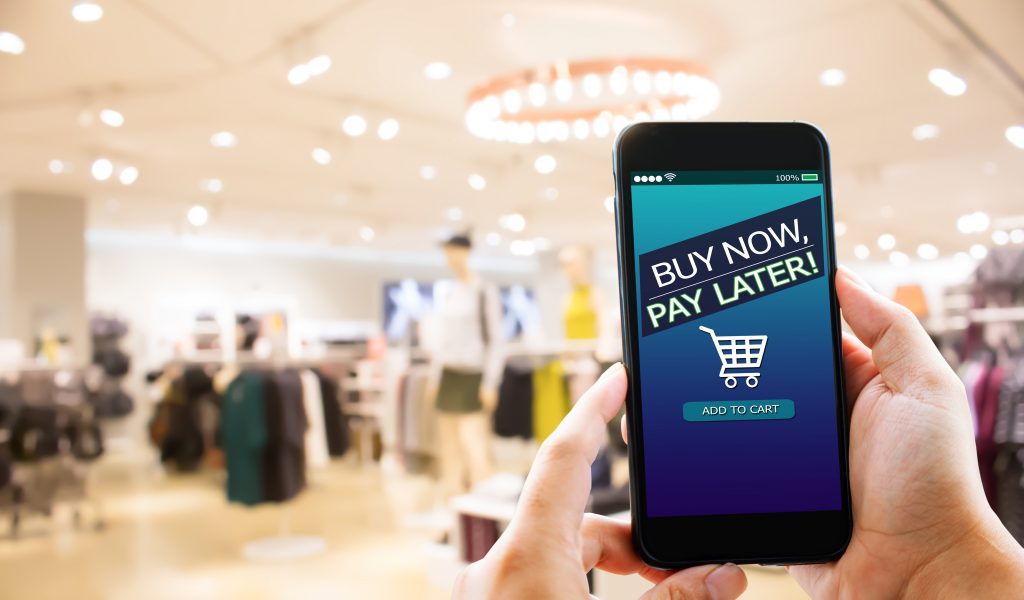
Buy Now, Pay Later (BNPL) allows shoppers to purchase goods and take possession of them straight away, but pay for them later.
For example, you might pay in weekly, fortnightly or monthly instalments; or in full, 14 or 30 days after the purchase.
BNPL is sometimes known as ‘point-of-sale’ credit. This is because it is offered at the physical or online checkout.
Different retailers work with different BNPL lenders – there might be just one BNPL option available at a high street or online checkout, or several.
Klarna is probably the best know BNPL company in the UK but there are many others. Some haven’t lasted the distance – Openpay and Zip no longer operate in the UK, for example.

Why Life Insurance Still Matters – Even During a Cost-of-Living Crisis
Sponsored by Post Office
Unlike more traditional forms of credit such as credit cards, BNPL companies don’t normally charge interest. Instead they make most of their money via commission from retailers. However, some firms have started to make money from charging customers late payment fees too.
Do I need a credit check to use BNPL?
You might need to pass a credit check to use a BNPL service.
A ‘hard’ credit check will leave a mark on your credit file that can be seen by other lenders, while a ‘soft’ check can only be seen by you.
The credit check will also be used to confirm your identity.
How are BNPL payments made?
Most BNPL lenders take payments automatically from your bank card via a ‘continuous payment authority’ (CPA).
This might sound convenient as you wouldn’t have to proactively make the payment. But if there is not enough money in your account the day the payment is due, you might be charged a late payment fee. If you get significantly into arrears, the BNPL provider may pass your case to debt collectors.
CPAs also mean that BNPL payments might be made when, given more control, you’d rather allocate the money to your rent or mortgage or another priority debt.
Who are the major BNPL players?
Klarna
Klarna offers consumers three options: Pay in 30 days, three interest-free instalments (days 1, 30 and 60), and Klarna Finance. Only Klarna Finance charges interest, with an interest rate up to 18.99%.
Klarna charges a late payment fee of up to £5 a week after the payment is due.
Clearpay
Clearpay lends you a fixed amount of credit which you repay over four instalments, due every two weeks, with no interest charged.
Clearpay charges a £6 late payment fee for each late instalment and a further £6 if it’s still unpaid a week later. Late fees are capped at £6 for orders under £24 and the lower of £24 or 25% of the order value for orders over £24.
Laybuy
Laybuy breaks your purchase down into six payments which are taken automatically from your bank account at weekly intervals.
If you miss a payment Laybuy charges you a late fee of £6. If you don’t make the payment within the next seven days, it will charge another late fee of £6. It will do this up to a limit of £24 for each time you buy something with Laybuy.
DivideBuy
DivideBuy was acquired by Zopa earlier this year. It allows shoppers to split purchases into up to 12 monthly instalments, with no interest charged.
Dividebuy may charge interest and late fees if you miss a payment – but its website doesn’t say how much. It hasn’t replied to a request from YourMoney.com for this information.
Zilch
Zilch is a BNPL virtual card that can be used at thousands of retailers, with debts repaid every two weeks over six weeks (four instalments).
Zilch doesn’t charge late payment fees but its warns that missed payments could affect your credit score.
Payl8r
Payl8r allows payment to be deferred for 30 days, interest-free. But after that, a typical APR of 127.34% will be charged. On top of interest, there is a £2 credit check fee (refunded if approved) and a £4.95 application fee.
Payl8r charges some of the highest fees for missed payments and arrears. If it attempts to take a payment and it fails, you’ll be charged £5 up to three times a month. These charges will be waived if you bring your account up to date within 28 days of the first fee being imposed. Payl8r also charges £30 if it sends your debt to a debt collector and £25 for an “unjustified Chargeback claim”.
How can you use BNPL?
When BNPL first began, it was typically used for purchases on items such as clothes, furniture and electronics. But now it is much more widely used on small purchases costing just a few pounds. You can even buy a takeaway and pay later after Klarna started partnering with Deliveroo in 2022.
Financial experts have warned about the increased use of BNPL schemes. OpenMoney found that the number of people using BNPL jumped from 49% in 2020 to 57% in 2021.
Meanwhile, a blog post by the Bank of England earlier this year found that more than three million people owe a collective £2.7bn on BNPL. Researchers cited the Financial Conduct Authority’s Woolard Review which covered unregulated BNPL products and found that the use of BNPL products nearly quadrupled in 2020 to transactions worth £2.7bn. Data collected from some BNPL providers revealed 25% of users are aged 18 to 24 and 50% are aged 25 to 36.
What are the dangers of BNPL?
While BNPL can help shoppers spread the cost of purchases, financial experts are concerned that it can result in cash-strapped people getting caught up in a circle of debt. There have been numerous studies that suggest people are becoming overly-reliant on this form of borrowing.
For example, a study by the Money and Pensions Service in September 2023 found that around one in five people using BNPL loans are doing so to purchase everyday essentials.
With each new purchase on BNPL, a new payment plan is set up. This means it is easy for borrowers to lose track of when payments are due. As money is taken straight from their card or bank account, multiple BNPL payments could mean there is not enough money left for priority debts such as mortgage or rent.
The problem can be worse where borrowers have several BNPL deals running with several different lenders at the same time.
Another concern is that people tend to use BNPL to overspend on items they wouldn’t normally be able to afford if they had to pay upfront. BNPL providers market their services to retailers on the proviso that BNPL boosts sales.
In some cases, naïve shoppers might not fully understand that BNPL is a type of debt, and simply think they have the option to delay payment. These people could unknowingly be exposing themselves to a range of issues if they fail to make payments on time, such as late fees, black marks on their credit report or having their case referred to a debt collector.
There is also anecdotal evidence from mortgage brokers that mortgage lenders might be reluctant to lend to borrowers with recent or repeated use of BNPL schemes.
While payments might not always show up on a person’s credit report (some BNPL lenders only report missed payments to credit reference agencies), mortgage lenders will be able to see evidence of BNPL payments on mortgage applicants’ bank statements.
Is BNPL regulated?
The Treasury announced in February 2021 that it would bring unregulated BNPL services under FCA regulation. Ministers then set out proposals regarding regulation in February 2023.
Regulation would give borrowers new rights and protections, including the ability to request Section 75 refunds and to escalate complaints to the Financial Ombudsman Service.
But regulation is yet to happen and in July 2023 there were rumours that the Government is considering ditching the idea over fears that it would prompt some BNPL lenders to cease operations in the UK. Ministers say such a move would not help struggling Brits during the cost-of-living crisis.
How can you manage BNPL debt?
If you use BNPL, or you are tempted to, follow these six tips to avoid BNPL debt becoming problem debt.
- Only use BNPL where you really have no other choice
- Read the fine print carefully and make sure you know when payments are due and that you can afford them
- Set up a budget and stick to it
- Contact the BNPL provider if you are having trouble affording repayments
- Speak to a debt charity such as Step Change if your debts become unmanageable
- Don’t ignore BNPL debt issues – they won’t go away on their own
